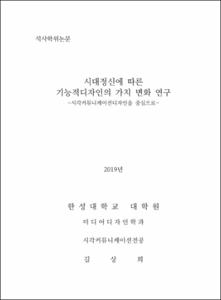시대정신에 따른 기능적디자인의 가치 변화 연구
= Changes of the Value in Functional Design through Zeitgeist: Focused on Visual Communication Design
- Type
- Thesis
- Alternative Title
- 시각커뮤니케이션디자인을 중심으로
- Department
- 대학원 미디어디자인학과
- Issued Date
- 2019
- Publisher
- 한성대학교 일반대학원
- Files in This Item:
-
-
Download
 200000215865.pdf
기타 데이터 / 3.63 MB / Adobe PDF
200000215865.pdf
기타 데이터 / 3.63 MB / Adobe PDF
-
Items in Repository are protected by copyright, with all rights reserved, unless otherwise indicated.